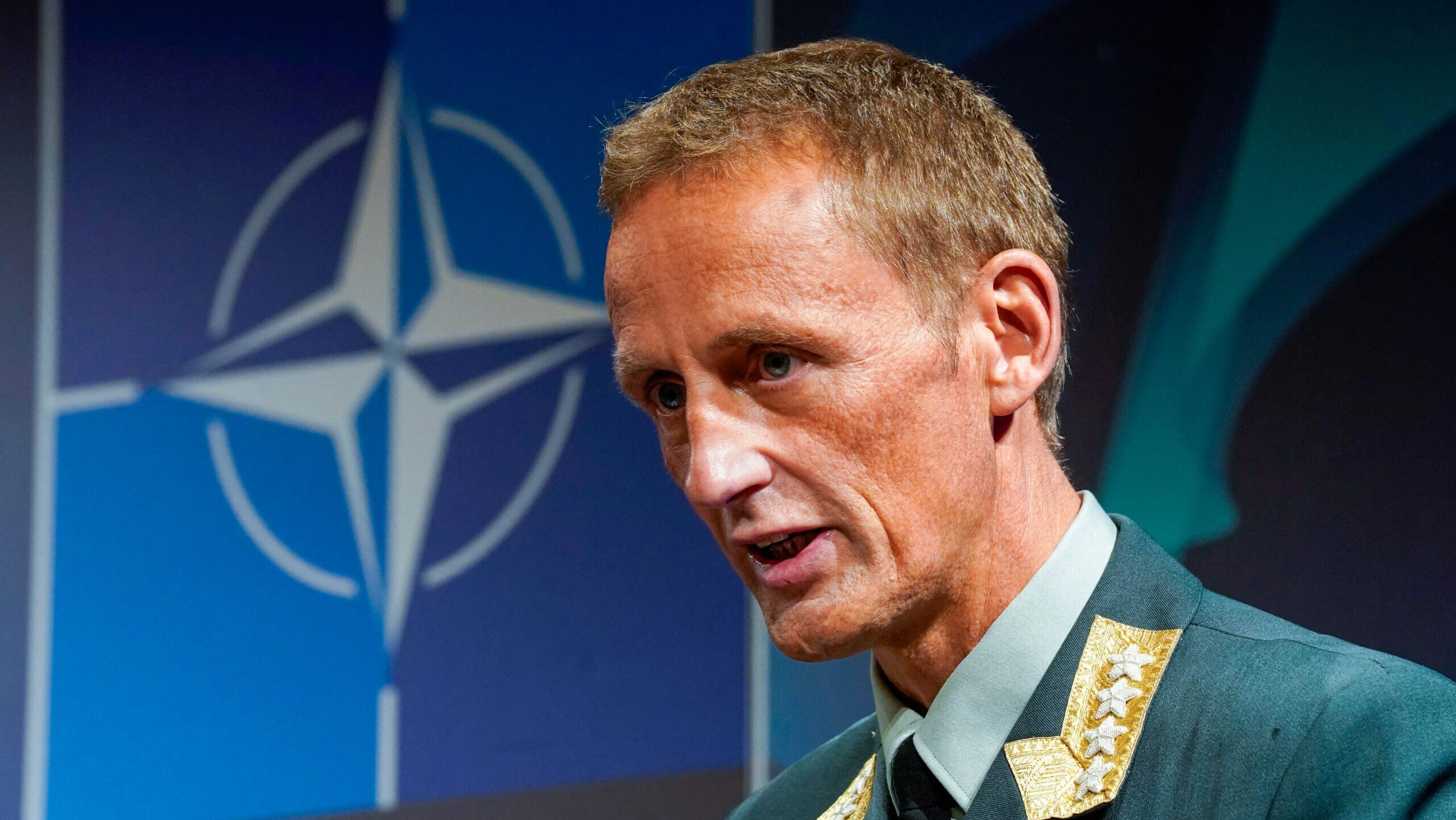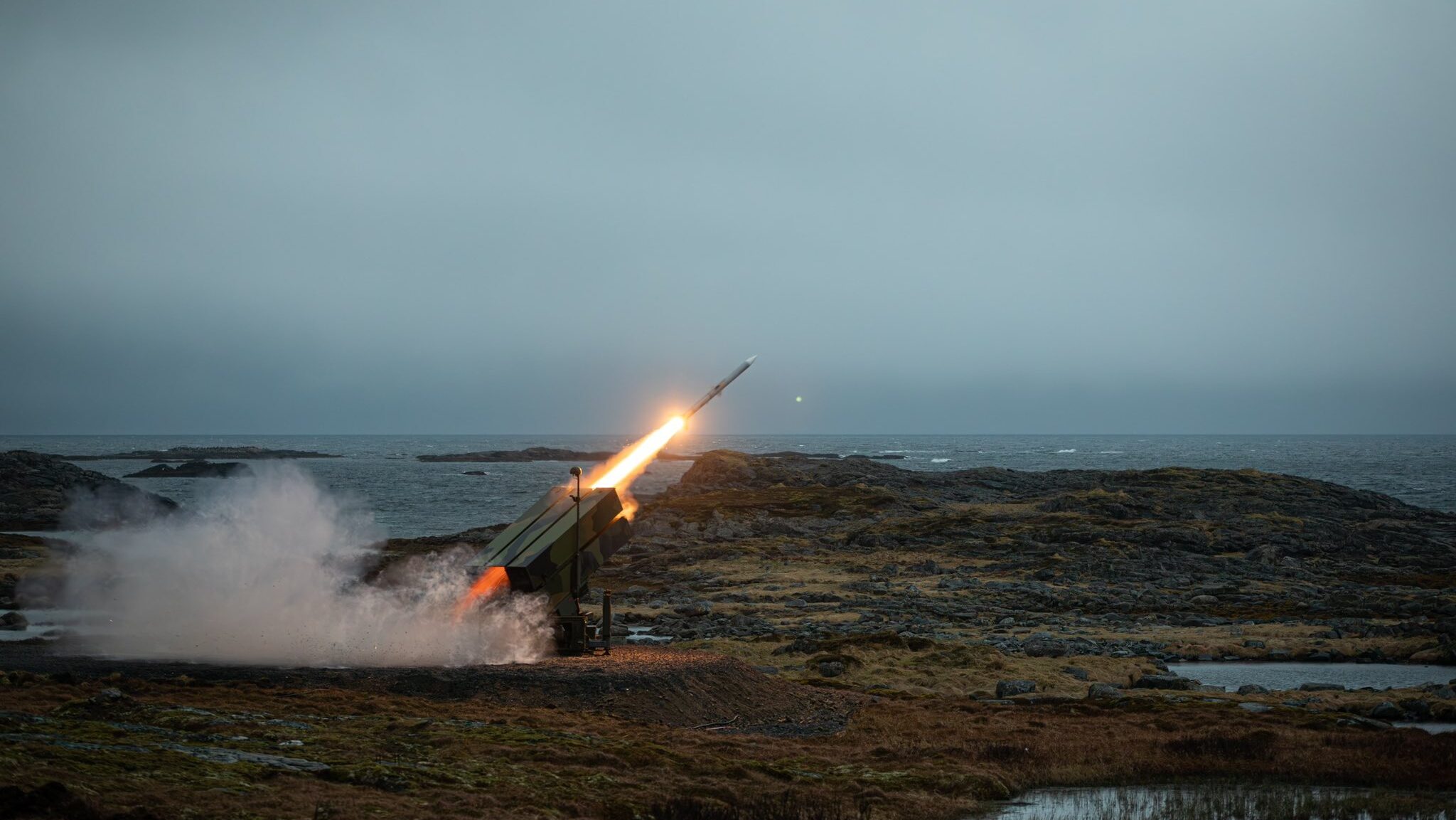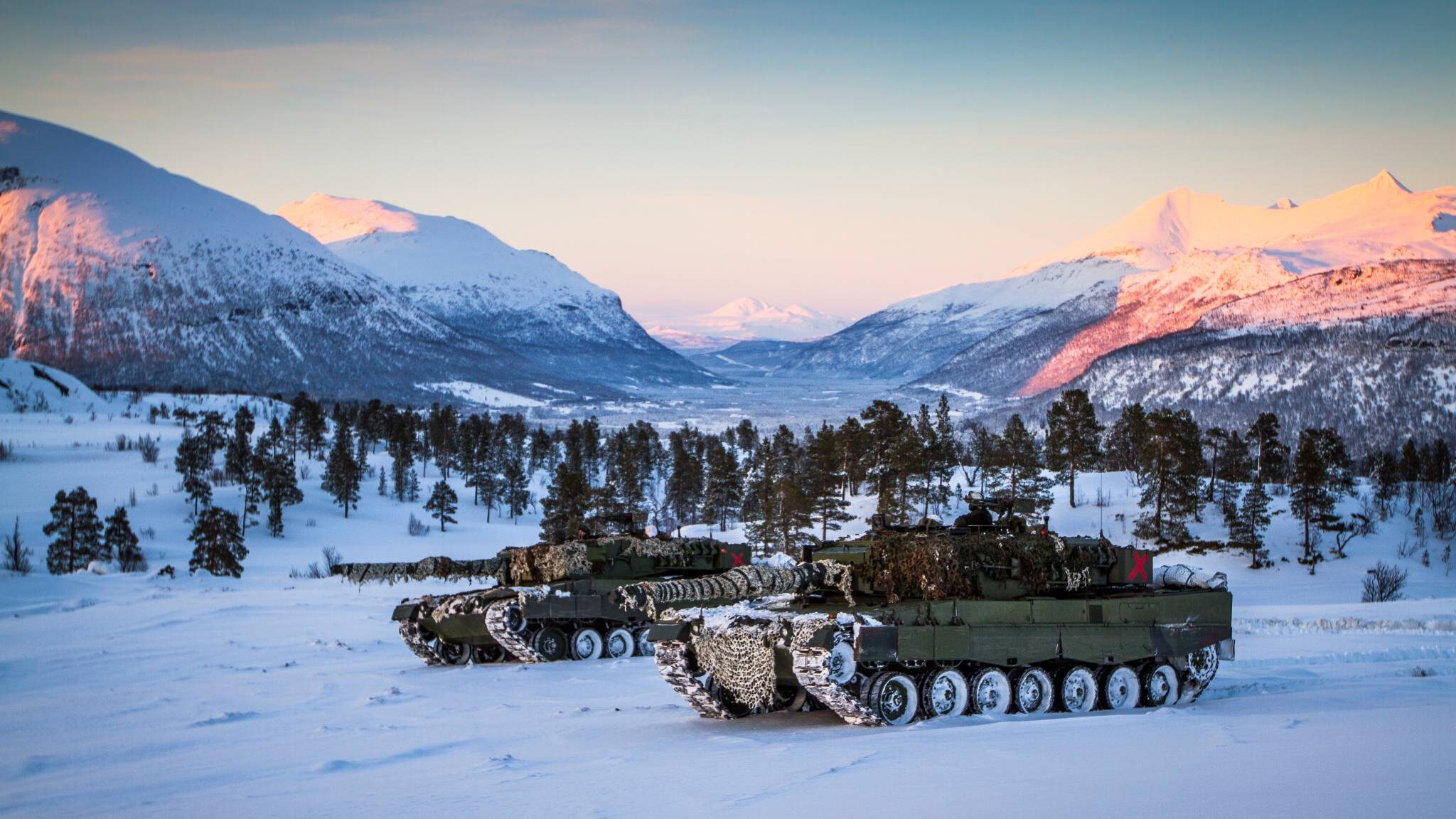
Gen. Eirik Kristoffersen, Norway’s Chief of Defense, addresses a press conference during the NATO Military Committee Conference 2023 (MCC23) at the Holmenkollen Scandic hotel in Oslo, Norway, on September 16, 2023. (Photo by LISE ASERUD/NTB/AFP via Getty Images)
WASHINGTON — Norway’s decision to double its defense spending over the next 12 years relied heavily on the advice of Norway’s Chief of Defense, Gen. Eirik Kristoffersen. During a recent visit to Washington, Kristoffersen sat down with Breaking Defense to discuss the thinking that went into the plan, what he views as his priorities, how he wants to work with industry and why he doesn’t want to see a “Norwegian solution” for his new frigate design.
This interview has been edited lightly for length and clarity.
BREAKING DEFENSE: The government in Oslo on April 5 announced a massive defense spending plan for the next 12 years. That obviously leaves a lot of time to make moves, so what is your nearest term priority for defense acquisition?
GEN. EIRIK KRISTOFFERSON: My main priority for this year is to continue to support Ukraine. It involves donations from our stocks. It’s training, and also education of Ukrainian soldiers. It’s working closely with industry, both on donations and training. We also need to refill our stocks with the equipment we are donating. So we are following that very closely. And then all the lessons learned. We have lessons learned from what the Russians are doing, and what they are learning. And then the lessons learned from the Ukrainian fight, how they use our equipment, and how they have been able to have this basically whole of society approach to defend Ukraine. And then there were lessons learned with partners within NATO and with all over the 50 nations that support Ukraine; lessons learned on how we actually support them, even down to specifics like how do we move material to Ukraine? How do we make sure our equipment is more standardized for the future? So there are so many lessons learned from this war. Support[ing] Ukraine is my main priority.
And then we need to have more air defense. That’s a more medium-term requirement. We need to speed up how we will change from platform thinking to effects thinking [on] long range fires, how we can do more multi-domain operations with a shorter decision process from sensor to shooter. We need to invest in unmanned technology, drones, vehicles. Underwater drones, you know, we need to increase that transition.
On the longer term, I’m looking for how should we replace the frigates we have with new ones, and what should the new surface fleet be for the Navy and the Coast Guard. And I want more standardized platforms. I want more flexible platforms. And I want platforms that that also can be maintained a certain level to do this with allies, I don’t want a Norwegian solution.
RELATED: Why supporting Ukraine is ‘main priority’ for Norway’s defense chief this year
Is there anything you’ve had to cut under the new plan, or have decided to move away from based on lessons learned from Ukraine?
No, no, and it goes back to the modernizing of forces that has been going on for so many years. I’m quite happy with the Air Force, the Navy will increase [under this plan], and then the Army is growing. There are no ongoing projects that I can come up with that we have to stop now.
I think the biggest challenge we have now is to invest in our digital backbone — everything from how do you store the large amount of data that you’re receiving now from our new platforms like the F-35 and our P-8s, how do you make that data available across the force? New satellite communications are essential to our communication infrastructure. There are things that need to be phased out and replaced by new technology. And also I need to change the whole system of the management of our force, basically the platforms you’re using to look at status or readiness. So it’s a huge deep digital change that is going on, which will take a lot of effort.
How much of that digital change is mirroring what the Pentagon is doing?
We will definitely look at other allies, and we have been doing this for some years. But what we have succeeded on is, how do you link platforms on the tactical level? How can you make sure that our F-35s can actually receive information from our Home Guard soldiers via an app. So we have been working on the tactical stuff, but it’s the digital backbone that we still need to work on. We also are starting to cut down on the variety of systems, so we don’t have so many variations of digital systems that you’re using. But it takes time. I am looking, of course, at what allies are doing, but also looking at what is available right now and what sort of systems are really flexible enough to be developed for the future. We want to do this continuously. We don’t want to move into one solution like we did in the late 90s. Then, we were very, very ahead of technology in the defense forces. Now we are falling behind. We went from one solution, you know 34 years later — it’s like the iPhone. I remember my first iPhone 4, and how many times have I replaced my iPhone since? It’s the same idea.
When we talked with your defense minister in 2022, he raised the idea that Norway needed to accept taking munition stocks below required levels in order to support Ukraine. How did that shake out?
We have looked at our own requirements at NATO requirements, and in some cases we had higher numbers required for a national level than from a NATO level. [That raised questions of] how much should we go down on our stocks. But at the same time industry has started to increase its production. So for instance, the anti tank weapons we gave in the beginning, they have been replaced already so. The effect of increased production artillery also gives us more volume in our own stocks than I expected, maybe a year ago.
From my point of view, to support Ukraine must be my main priority, but the second is to make sure that industry actually can increase [weapons] production in the next two, three years so you can refill faster. Luckily enough, Norway started to increase its stocks back in 2016, that was sort of starting to change. So we actually had something to deliver. I can see that the effect of that now when we look on their continuous support Ukraine. But if you’re going to support Ukraine to the extent they need, it’s definitely relying on increased production from industry.
What about outside of munitions? Stocking spare parts is also part of Norway’s national strategy.
The latest thing we have been looking at now is really looking hard into the possibilities for new technology. Like instead of having spare parts, can you start 3D printing, so basically you store quality steel powder, and then you need the data papers from industry to produce the spare parts. The Norwegian oil industry is moving in that direction. When we went through [military] stocks for us to support Ukraine, we discovered all kinds of strange things that we had in our stocks — we found spare parts for the frigate that we stopped using maybe 15 years ago. So how can you change the whole logistics system based on new technology? I think 3D printing will change how we think about stocks as well.

A Norwegian National Advanced Surface-to-Air Missile System (NASAMS) in action during exercise Formidable Shield (Norwegian Armed Forces on X)
Is that something you guys are already working towards right now or is that a hypothetical?
We have concrete examples from industry. And we have started using 3D printing, but that’s more for replacing spare parts [in the field]. But then you need to change the whole concept from the industry as well. Because if you sell a main battle tank, you also sell spare parts. If you just sell technical specifications for 3D printing those spare parts, how do you do that [in a way that works for industry]?
So you’re comfortable with where you are for your own needs versus Ukraine right now? Or do you feel like you’ve had to accept more risk in terms of your own needs to be able to support Ukraine?
No, I’m comfortable with our status in Norway. Because what we see is that Russia is occupied in Ukraine, so there’s no conventional threat on our borders. If you look at the number of troops in Russia, just before the 24th of February, you had two brigades on the Norwegian border. And then you had one brigade outside the Finnish border — basically, three brigades in our close area. Now 80 percent of those units are being deployed to Ukraine, and many of them have been destroyed in Ukraine.
I always said, we have a window. But I don’t know how long this window will last. I don’t know to what extent Russia will rebuild their forces. And I don’t know how they will balance air, land and sea forces. And I don’t know what lessons learned the Russians will draw from the war in Ukraine. So there might be a different set of forces on their border based on what they have learned in Ukraine. What we are seeing now is that, sometimes Russia is moving units up to the high north, they’re training there, then they’re being deployed to Ukraine. So when you ask me if I’m comfortable, I don’t think I will ever be that, because we always need to have enough in our stocks. But [right now], the war is in Ukraine and that’s where we need to support.
RELATED: Norway’s air defense priorities: Volume first, then long-range capabilities
In last year’s military advice, you said Norway should have six frigates and six submarines under your best case situation. Under this plan you’re getting only five of each. Is that a disappointment for you?
We had discussions with the government through the whole year, because that advice was already one year old. And we looked at budgets and everything, and we adjusted all the time, [to find] the best outcome. So I was very involved, and my defense staff was also very involved in the work as it continued. Of course, six is better than five, everybody understands that — but five is much, much better than four. If you have five instead of four, that’s when you get the effect, much more effect out of the platforms you have. Six, you can even get more, but five is significantly better than four.
Submarines are easy, because we’re already working with Germany, and they’re starting production on a new submarine. So just to add one, we’ll see if Germany does it as well, and then if they add more it will take more time, I guess, if they don’t open a new production line. When it comes to frigates, I said that we need to do the same as with the submarines: We need to do it in close cooperation with one ally, at least. So we need the same frigate as another ally. We cannot be the one user of a system, we are too small for that. I think that’s also lessons learned from Ukraine, you need much more standardized platforms, much more standardized weapon systems, much more standardized data, logistics.
You mentioned earlier that you don’t want a “Norwegian solution” that is purely local, because Ukraine has taught the importance of having interoperability across the alliance. The problem has always been that local governments view their local industries as jobs programs as much, if not more, than national security enterprises. So how do you get countries to buy in on that idea?
I don’t see the problem with that, really. It could be a problem if you say that we’re going to buy exactly the same product. But this is not about the same product, it’s about standardized products. If the standards are there, you can still have different producers. But if you don’t apply to the standards, you should definitely not buy it.
Ukraine is mirroring the problem we have in NATO, with all the equipment they receive. So we need to standardize this. We’ve ended up in a situation where, right now my German-made Leopard tanks in Lithuania, in a German led battalion in Enhanced Forward Presence, are not allowed without a lot of bureaucracy to use German made [munitions], because we lost something on the standardization on the way. I understand national industry will always play a big role. But I don’t see the problem between standardization and [supporting] national industry.

Two Leopard tanks at Setermoen fire range during Cold Response 2014. (Marius Kaniewski, Norwegian Armed Forces)
When we talked two years ago, you raised the point that while adding Finland and Sweden to NATO was undoubtedly a good thing for Norway’s security, it also meant more complications in your defense planning, plus the integration headaches. Now that they’re both in the alliance, how has that process gone?
The Nordic chiefs of defense, all five including Iceland, we have met either two or three hours, or four hours or five, at least once a month [in the last few years]. So we meet regularly, either by VTC, or by physical meetings, or by skiing together. We have done all these things, and we have been working hard. In August 2022, we gave advice to our political leaders that the Nordic countries, we should integrate our armed forces. Everybody should have a balanced force to defend their own country, but you should integrate in the land, sea, air, cyber and space domain, and also we should integrate our total defense concepts. When it comes to across the borders, we should basically be an integrated region. And we should integrate that into NATO, so that we don’t become like a Nordic bloc, it should be a part of NATO
We want to go very far. I want to go as far as you know, make it easy for any Norwegian unit to train in Finland or Denmark or Sweden if they want to, without all the bureaucracy that goes with it. So cross border thinking, like we’ve done with the Air Force across the Nordic countries for many years. We should do that in that land domain.
How far can integration really go, given all five countries need to maintain their domestic priorities?
That’s why I’m talking about Article Three and Article Five. So every nation is responsible [for our individual countries] under Article Three. I align my national plans with NATO plans, then they are, you know, far on meeting the force structure requirements for NATO. NATO is nothing more than 32 nations, and each nation has to has to provide what’s most needed. And there are some good things [about differences] as well: Norway will have F-35, in Finland F-35, Denmark F 35, but Sweden will have fourth-generation Gripen. And when we exercise together, you actually see the benefits. You can see scenarios where you used F-35s for some things and then use Gripens for other things. And then you combine this, they actually give some effect. So, there are there are some benefits with having different capabilities as well.
On the political side, in the Nordic countries, from our Prime Minister, [he said] that the Nordic regions should be the most integrated region by 2030 in Europe. So I want to explore that. For me I want it to be as easy for me to send a Norwegian officer to work in a Finnish headquarters as to work in a Norwegian headquarters. So I want to take it as far [as we can] but then you start challenging also different legislations, even down to how you pay your officers and soldiers and NCOs when they work outside the borders and all those things that you run into when you start working in different countries.






















